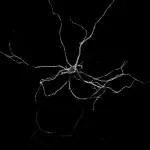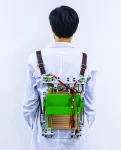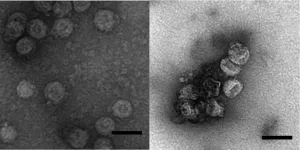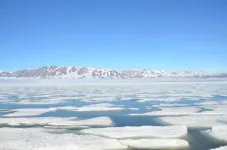Neurons: 'String of lights' indicates excitation propagation
Method developed further at the University of Bonn makes it possible to watch nerve cells at work
2021-02-03
(Press-News.org) A type of novel molecular voltage sensor makes it possible to watch nerve cells at work. The principle of the method has been known for some time. However, researchers at the University of Bonn and the University of California in Los Angeles have now succeeded in significantly improving it. It allows the propagation of electrical signals in living nerve cells to be observed with high temporal and spatial resolution. This enables investigations into completely new questions that were previously closed to research. The study has now been published in the journal PNAS.
When we smell a bottle of suntan lotion, electrical pulses are generated in the sensory cells of the nose. Via the olfactory bulb in the brain, they enter the primary olfactory cortex, which then distributes them to various brain centers. Memories such as summer vacations by the sea long ago are then conjured up in the hippocampus and other regions.
In recent decades, brain researchers have gained an increasingly precise idea of how stimuli are processed in the brain and which path the electrical excitation takes in the process. However, in many aspects these insights are still very approximate. The method now presented by researchers at the University of Bonn and the University of California in Los Angeles may help solve this problem.
Nerve cells transmit electrical signals to other nerve cells via biological "cables" known as axons. Each nerve cell is encased in a thin membrane that separates it from its environment. In the resting state, there are many positively charged ions on the outside of this membrane, significantly more than on the inside. There is therefore an electrical voltage between the inside and the outside. Neuroscientists also speak of a membrane potential.
Light chain for nerve cells
When a signal passes a certain point on the axon, this potential changes there for a short time. "And we can make this change visible," explains Prof. Dr. Istvan Mody of the Institute for Experimental Epileptology and Cognition Research (IEECR) at the University of Bonn Medical Center. To do this, the researchers drape a chain of lights around the nerve cells, so to speak. The special thing about it: Each lamp of this chain carries a voltage-dependent dimmer. This means that it gets darker when the membrane potential at the location of the lamp changes.
This makes excitation propagation visible as a kind of "dark drop" running along the axon. The researchers use fluorescent proteins as a light chain. "We introduced the gene for this into the cells," Mody explains. The researchers also tagged the genetic makeup with a kind of shipping label. "This label ensures that the fluorescent dyes are transported to the outside of the membrane immediately after they are produced. A kind of anchor then ensures they stay put."
The dimmer is not part of the nano lamp, but another molecule: a so-called "dark quencher". This is normally located on the inside of the membrane. However, due to the voltage change during signal forwarding, it changes to the outside. There it meets the fluorescent proteins and shields them. The nano lamp becomes darker as a result. As soon as the potential normalizes, the dark quencher moves back to the inside, and the luminosity increases again.
"This method is not really anything new," Mody says. "However, we have fundamentally improved it in two respects." Until now, the fluorescent proteins were integrated directly into the membrane, which significantly disrupted the function of the neurons. The new nano lamps, in contrast, sit outside the membrane. They also do not fade as quickly, but retain their luminosity for 40 minutes, four times as long as conventional fluorescent dyes.
Highly explosive dimmer
The second change concerns the dark quencher: The compound normally used for this purpose is toxic and also highly combustible. It was even used as an explosive during the Second World War. "Our quencher, on the other hand, is completely harmless," Mody emphasizes. "It also reacts even faster and more sensitively to the smallest changes in potential. This allows our method to visualize up to 100 electrical pulses per second."
The method permits the function of nerve cells to be observed without disturbing them. This makes it possible, for instance, to gain a more precise insight into the associated malfunctions in certain neuronal diseases. It is ultimately a promising new tool to better understand the workings of the brain.
INFORMATION:
Funding:
The study was funded by European Research Council Advanced Grant 339620.
Publication: Therese C. Alich, Milan Pabst, Leonie Pothmann, Bálint Szalontai, Guido C. Faas, and Istvan Mody: A dark quencher genetically encodable voltage indicator (dqGEVI) exhibits high fidelity and speed. PNAS, https://doi.org/10.1073/pnas.2020235118
Contact:
Prof. Dr. Istvan Mody
Institut für Experimentelle Epileptologie und Kognitionsforschung (IEECR)
Universitätsklinikum Bonn
The David Gaffen School of Medicine at UCLA Los Angeles
Tel. +49-228-6885-331
E-mail: mody@ucla.edu
Therese Christine Alich
Institut für Experimentelle Epileptologie und Kognitionsforschung (IEECR)
Universitätsklinikum Bonn
Tel. +49-228-6885329
E-mail: ThereseCAlich@uni-bonn.de
[Attachments] See images for this press release:

ELSE PRESS RELEASES FROM THIS DATE:
2021-02-03
Hikers, soldiers and school children all know the burden of a heavy backpack. But now, researchers have developed a prototype that not only makes loads feel about 20% lighter, but also harvests energy from human movements to power small electronics. The new backpack, reported in ACS Nano, could be especially useful for athletes, explorers and disaster rescuers who work in remote areas without electricity, the researchers say.
Backpacks are widely used in everyday life for the hands-free carrying of loads. Over time, however, walking or running with a heavy sack can cause back and neck pain. Also, backpackers ...
2021-02-03
Environmentally conscious consumers try to "buy local" when food shopping. Now, a study of food raised around Chicago has shown that buying local can't provide all necessary nutrients for area residents, though it could fulfill their needs if some nutrients were supplied as supplements. The researchers report in ACS' Environmental Science & Technology that urban agriculture made little difference in reducing overall land area, and thus distance, required to supply all nutritional needs.
As the U.S. population continues to flow to urban regions, consumers are moving farther from farms and croplands. This limits nutrient recycling and drives up emissions associated with transporting ...
2021-02-03
Enveloped viruses have been detected in raw sewage and sludge, but scientists still don't fully understand the fate and infectivity of these viruses during water purification at treatment plants. Now, researchers reporting in ACS' Environmental Science & Technology have discovered that a standard water treatment technique, called iron (III) coagulation, and its electrically driven counterpart, iron (0) electrocoagulation, can efficiently remove and inactivate a model enveloped virus.
Enveloped viruses have an outer coating of lipids and proteins that helps protect their genetic material. Typically, disrupting this coat inactivates the virus. Until now, most studies have investigated ...
2021-02-03
Oxygen is essential for human life, but within the body, certain biological environmental conditions can transform oxygen into aggressively reactive molecules called reactive oxygen species (ROS), which can damage DNA, RNA, and proteins. Normally, the body relies on molecules called antioxidants to convert ROS into less dangerous chemical species through a process called reduction. But unhealthy lifestyles, various diseases, stress, and aging can all contribute to an imbalance between the production of ROS and the body's ability to reduce and eliminate them. The resulting excessive levels of ROS cause "oxidative stress," ...
2021-02-03
ATLANTA - FEBRUARY 3, 2021 - New study finds more than half (56.4%) of cancer survivors in the United States reported having additional underlying medical conditions associated with severe COVID-19 illness. The report appearing in JNCI: The Journal of the National Cancer Institute, suggests that prevalence of these conditions among cancer survivors is nearly 40% higher than that in the general population.
Cancer, and other underlying medical conditions, including chronic obstructive pulmonary disease, heart diseases, diabetes, chronic kidney disease, and obesity, are associated with increased risk of severe COVID-19 illness. For this study, investigators Changchuan (Charles) ...
2021-02-03
A can of Red Bull next to the computer mouse, a bag of potato chips next to the keyboard - that's how many people imagine nutrition in eSports. "The energy drink is indeed part of the diet for many," says Professor Ingo Froböse, head of the Institute of Movement Therapy and movement-oriented Prevention and Rehabilitation at the German Sport University Cologne, "but overall, eSports players actually eat better than the general population."
This is the result of the third eSport study by the German Sport University Cologne, which was presented in Cologne on February 3, 2021. The two previous eSport studies focused on training ...
2021-02-03
As the sea ice shrinks in the Arctic, the plankton community that produces food for the entire marine food chain is changing. New research shows that a potentially toxic species of plankton algae that lives both by doing photosynthesis and absorbing food may become an important player in the Arctic Ocean as the future sea ice becomes thinner and thinner.
Microscopic plankton algae, invisible to the naked eye, are the foundation of the marine food web, feeding all the ocean´s living creatures from small crustaceans to large whales. Plankton ...
2021-02-03
A study of factors associated with Post-Traumatic Stress Disorder (PTSD) has led to a number of novel findings linking nutrition to experiences of PTSD. Notable among them is the discovery that Canadians, between the ages of 45 and 85, were less likely to exhibit PTSD if they consumed an average of two to three fiber sources daily.
"It is possible that optimal levels of dietary fiber have some type of mental health-related protective effect," says Karen Davison, Director of the Nutrition Informatics Research Group and Health Science Program Faculty Member at Kwantlen Polytechnic University. "This may be due to the communication network that connects the gut and brain via short chain fatty acids (SCFAs), which are metabolic byproducts of bacterial ...
2021-02-03
Eating too much fat and sugar as a child can alter your microbiome for life, even if you later learn to eat healthier, a new study in mice suggests.
The study by UC Riverside researchers is one of the first to show a significant decrease in the total number and diversity of gut bacteria in mature mice fed an unhealthy diet as juveniles.
"We studied mice, but the effect we observed is equivalent to kids having a Western diet, high in fat and sugar and their gut microbiome still being affected up to six years after puberty," explained UCR evolutionary physiologist Theodore Garland.
A paper describing the study has recently been published in the END ...
2021-02-03
A brain-related visual impairment, which until recently was thought to be rare, may affect one in every 30 children according to new research investigating the prevalence of Cerebral Visual Impairment [CVI]. The University of Bristol-led findings published today [3 February] in Developmental Medicine and Child Neurology, aim to raise awareness of CVI among parents and teachers to help them identify signs of the condition earlier.
The brain is just as important as the eyes when it comes to seeing, and many vision problems are caused by areas of the brain that are needed for sight not working properly and cannot be resolved by wearing glasses. Brain-related vision ...
LAST 30 PRESS RELEASES:
[Press-News.org] Neurons: 'String of lights' indicates excitation propagation
Method developed further at the University of Bonn makes it possible to watch nerve cells at work





